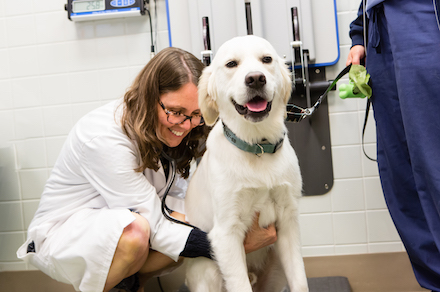Addison’s Disease (Hypoadrenocorticism)

Background
Named after Thomas Addison, the Scottish physician who first described the disease in humans, Addison’s disease (more correctly known as hypoadrenocorticism) occurs when there is an underproduction of the steroid hormones by the adrenal glands. The most common cause of canine hypoadrenocorticism is the destruction of the adrenal glands by the pet’s own immune system, although adrenal gland tumors or certain medications can also result in steroid hormone deficiency. Hypoadrenocorticism is extremely rare in cats and is less well characterized than the disease is in dogs.
In a normal dog or cat, the two major steroid hormones produced by the adrenal gland are cortisol and aldosterone. Cortisol is a stress hormone that regulates metabolism and the production of glucose. A deficiency in cortisol can result in low blood sugar. The hormone aldosterone regulates the body’s electrolytes, specifically the levels of potassium and sodium in the blood, both of which are important for normal nerve and muscle function. Aldosterone deficiency causes potassium to build up in the blood which, in severe cases, can lead to an irregular heartbeat or stop the heart entirely. The atypical form of hypoadrenocorticism occurs when there is only a deficiency in cortisol while aldosterone levels remain normal.
Risk Factors
Addison’s disease can affect dogs at any age, although it is commonly seen in young adult female dogs with the following breeds more prone to developing this condition:
- Bearded collies
- Cairn terriers
- Cocker spaniels
- Great Danes
- Nova Scotia duck tolling retrievers
- Portuguese water dogs
- Soft coated wheaten terriers
- Standard poodles
- West Highland white terriers
Signs
Common signs of Addison’s disease include:
- Vomiting
- Diarrhea
- Loss of appetite
- Weight loss
- Lethargy
- Increased thirst
- Increased urination
- Dehydration
- Shaking/trembling
These signs may occur intermittently and be present for days, weeks, or months before a diagnosis is made. If the disease persists untreated, it can lead to an adrenal or Addisonian crisis, which is a stage of the disease in which the dog or cat experiences life-threatening symptoms such as shock or collapse. This is considered a medical emergency. Urgent treatment with intravenous fluids containing dextrose will be needed to restore the body’s fluid, sodium, potassium, and sugar levels back to normal.
Diagnosis
Initial bloodwork showing an increase in blood potassium concentration and a decrease in blood sodium concentration helps veterinarians to recognize hypoadrenocorticism as a potential diagnosis. Atypical hypoadrenocorticism is more difficult to recognize because the sodium and potassium concentrations remain normal. In order to confirm a diagnosis of hypoadrenocorticism, your veterinarian will run an adrenocorticotropic hormone (ACTH) test to stimulate the adrenal glands to produce cortisol. The cortisol levels are measured before and after stimulating the adrenal gland with ACTH. Hypoadrenocorticism is confirmed if the level of cortisol in the blood remains low after stimulation. Your veterinarian may also order an ECG to check for any changes in heart function.
Treatment
As there is no cure for hypoadrenocorticism, treatment is lifelong but easily achieved through hormone replacement therapy. To replace cortisol levels, prednisone must be given daily. To replace aldosterone levels, your dog may be given fludrocortisone daily or may receive desoxycorticosterone pivalate (DOCP) injections monthly. Following diagnosis, the patient will need to have their potassium and sodium levels checked until the correct dosage is established and then less frequent rechecks will be necessary.
Prevention
There is no way to prevent hypoadrenocorticism from developing. However, dogs that are diagnosed with hypoadrenocorticism have a great prognosis so long as they continue to receive hormone replacement therapy. If your dog is diagnosed with hypoadrenocorticism and they experience an illness or condition that prevents them from taking their medication, this can lead to an adrenal crisis which is a medical emergency.
Make an Appointment





























